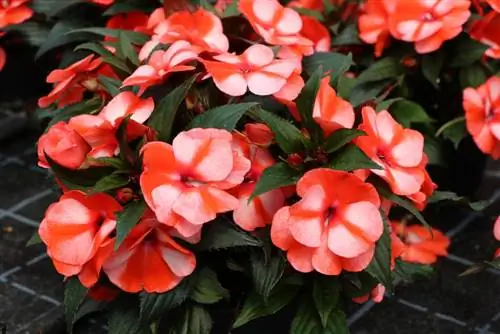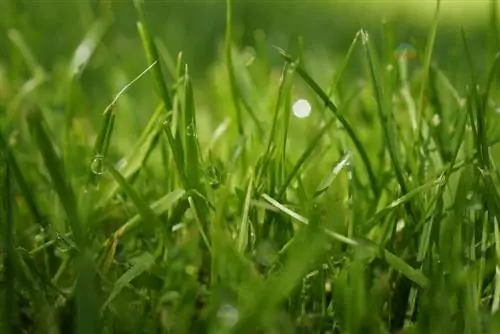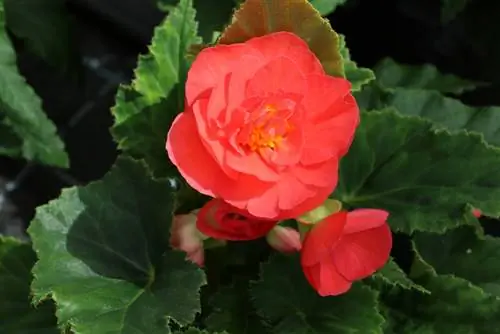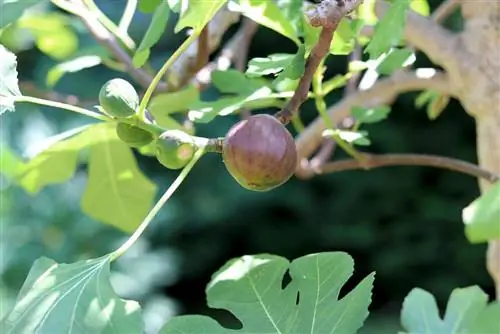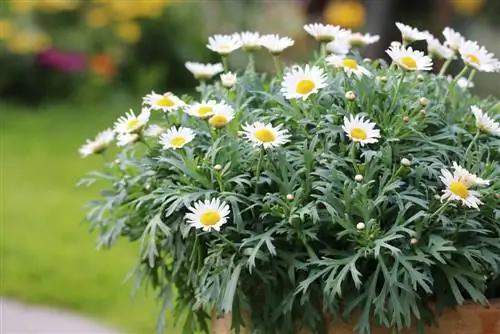- Author admin [email protected].
- Public 2023-12-17 03:39.
- Last modified 2025-06-01 06:48.
The flowering miracle of summer is the begonia. It is one of the classics among garden plants, but also house plants. Their original home is the tropical rainforest. Today it appears in our gardens in pots or outdoors as an uncomplicated plant that feels at home on the balcony, terrace and also in living rooms with various crosses in many color variations and patterns. If the begonias are to be overwintered, there are a few things to consider.
Overwintering indoor begonias
The plants can be kept warm over the winter, for example in the living room. If the begonia is kept a little cooler, you can enjoy its flowers for longer. However, the plants should not be placed near radiators. When it comes to the plant substrate, care should be taken to ensure that it does not get too wet, but the plant must not dry out either. Since the moisture damages the begonia, you should not water it too much. When overwintering, the begonia doesn't like being too dark, but the south window is not the right location either. It should not be placed on a windowsill with a radiator underneath.
Overwintering outdoor begonias
Begonias should be removed from the bed after the leaves have fallen. If there are still leaves, they are shortened to 2 centimeters. The plant should definitely be taken in before the first frost, they are very sensitive to frost. It can be overwintered if it is placed in a dry and loose plant substrate. This requires a frost-free room, for example in the basement. It doesn't have to have light, the temperatures are ideally around 10 degrees. Potted plants, on the other hand, can remain in the substrate in the pots, but here the rule is to keep them dry and frost-free. Under no circumstances should the tubers be too moist; if they are sprayed lightly from time to time, that is completely sufficient. The following year in February or March the tubers can be put back in the ground. Then you can water moderately. The plant should be kept a little warmer in the early year. When overwintering begonias, it is very important that the room is ventilated regularly. If new leaves form, you can fertilize again. After the Ice Saints, they can be placed or placed outdoors.
Tips
- When planting begonia tubers, make sure that the hollow side of the tuber is on top, it is just covered with less soil.
- If you don't have that much space, you can take the begonias out of the pot or the ground to overwinter.
- If the plant is overwintered in an air-dry room, it should remain in the pot so that it cannot dry out completely. Here too, spray with water from time to time.
- If you are generous with the water, it is better to remove the tuber from the ground.
- If the outdoor begonias are overwintered in a warm room, they will sprout too early and rot.
Begonias are easy to care for overwintering
Begonias or their tubers freeze to death at 0 °C and are overwintered frost-free. It should be noted that watering begins more sparingly at the end of September. This causes the leaves to slowly wilt and the plants to dry out. This process draws the energy reserves from the leaves into the tubers. If the begonias are in bloom for too long, they will lose their vigor and will therefore bloom weaker the following year.
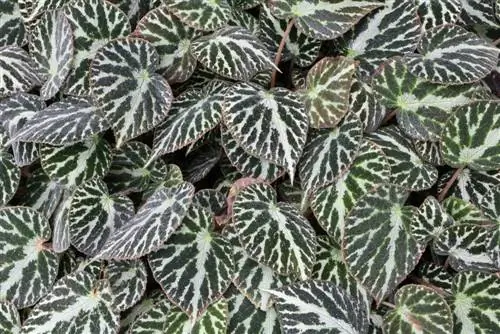
The begonias can be overwintered in the basement to save space. Before the first frost, they should be brought into the house or overwintering room and cut back to hand height. Check for pest or rot infestation and clean out affected plants or parts of plants. A dry substrate, newspaper or sand is good for the plant and it can overwinter in it. The room should be dry and frost-free and have a temperature of 8 °C.
Substrate and soil
When the begonias come back outdoors after the Ice Saints, the soil should be nutrient-rich and permeable. Like other flowering plants, the begonia needs a lot of nutrients. However, it doesn't like waterlogging as this causes the tuber to rot. It is therefore important that the soil is permeable. The begonia doesn't like clay soil. But if there is only clay soil, sand must be mixed in.
- well-drained soil
- sufficient nutrients
- Mixture of humus soil and sand 1:1 is cheap
Watering and fertilizing
If you give your begonias too much water, you will do more harm than not enough.
Tip:
There are balcony boxes with an irrigation system, so the plant can survive without water for a week.
The bale should not be completely dried out. When temperatures are high, you may forget to water for a day. The plant likes regular and moderate watering. Since it is sensitive to waterlogging, the top layer of soil should be thoroughly dried before watering again. Never leave liquid in the planter. To prevent this, it is best to set it up without the planter. When watering, do not pour over the leaves and flowers. At the end of August, less watering is recommended so that the leaves have withered by autumn. Fertilize every 14 days during the flowering season with a liquid fertilizer for flowering plants.
Diseases and pests
Begonias are susceptible to fungal diseases, including powdery mildew and gray mold. This occurs when the plant is kept too moist. Remove affected parts completely and spray with a mixture of water and milk, using one part whole milk and nine parts water. Pests are not that common; aphids are sometimes found, which can be controlled with a detergent solution. The leaflets are actually worse and can destroy an entire plant. If soft skin mites are found, give the plant a good shower, but first waterproof the pot.
Sowing
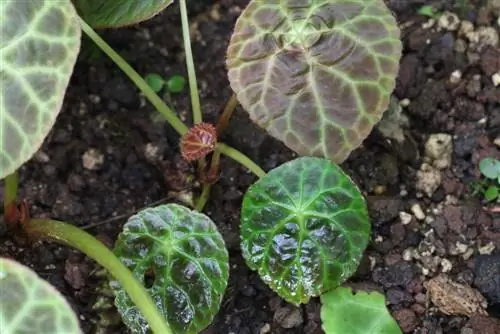
Begonia seeds are very small. When sowing, you should make sure that not too many are sown next to each other. If you sow in December, you can enjoy the flowering plants from mid-May.
Frequently asked questions
Which location do begonias prefer?
Begonias grow and thrive in partial shade and shade and do not like direct sunlight.
How do I get cuttings?
Cuttings are cut at the beginning of the growing season, in spring to the beginning of summer. You can root them in a glass of water, but also in the ground. Once enough roots have formed, they can be placed in the ground.
When should the begonia be repotted?
If the begonia is growing vigorously and the pot is too small, it can be repotted carefully. But you should make sure that the roots, flowers and leaves are not damaged.
What you should know in brief
as a houseplant
- As a houseplant, the begonia needs a lot of water. As a rule, replenishment is needed when the top layer of soil has dried.
- The leaves and flowers must not be watered when watering. Despite the high water requirement, waterlogging must be avoided.
- Good drainage is therefore absolutely necessary. Fertilizer should be added to the irrigation water every two weeks during the flowering period.
- In winter, there should be good humidity in the room: either with the help of a humidifier or daily misting.
outdoor
- Outside, the begonia definitely doesn't want a place where it is fully exposed to the midday sun.
- Otherwise your leaves and flowers would burn. There are now also species bred specifically for a location in the sun.
- The rule of thumb for the partially shaded species is no direct sunlight from 10 a.m. to 5 p.m. in the summer in the morning.
- As with houseplants, outdoor begonias always want to have enough water available.
- If the weather is pleasant, watering 2 - 3 times a week is enough.
- Since it is often difficult to fertilize regularly every 1 - 2 weeks, adding a stock fertilizer is recommended.
- Begonias outdoors can delight you for several years. Unfortunately, they are not resistant to frost.
Wintering
- If the begonias are in the bed, the tubers should be dug up after the leaves have fallen off.
- These are then placed in dry, loose substrate and placed in a frost-free room.
- If the begonias are in a container, you can just as easily put it in a frost-free room over the winter.
- In this case, it is not necessary to dig up the tubers.
- It is important for both types of overwintering to ensure that the tubers are kept as dry as possible to prevent rot.
- In spring (February/March) the tubers are put back into the bed and watered sufficiently.

